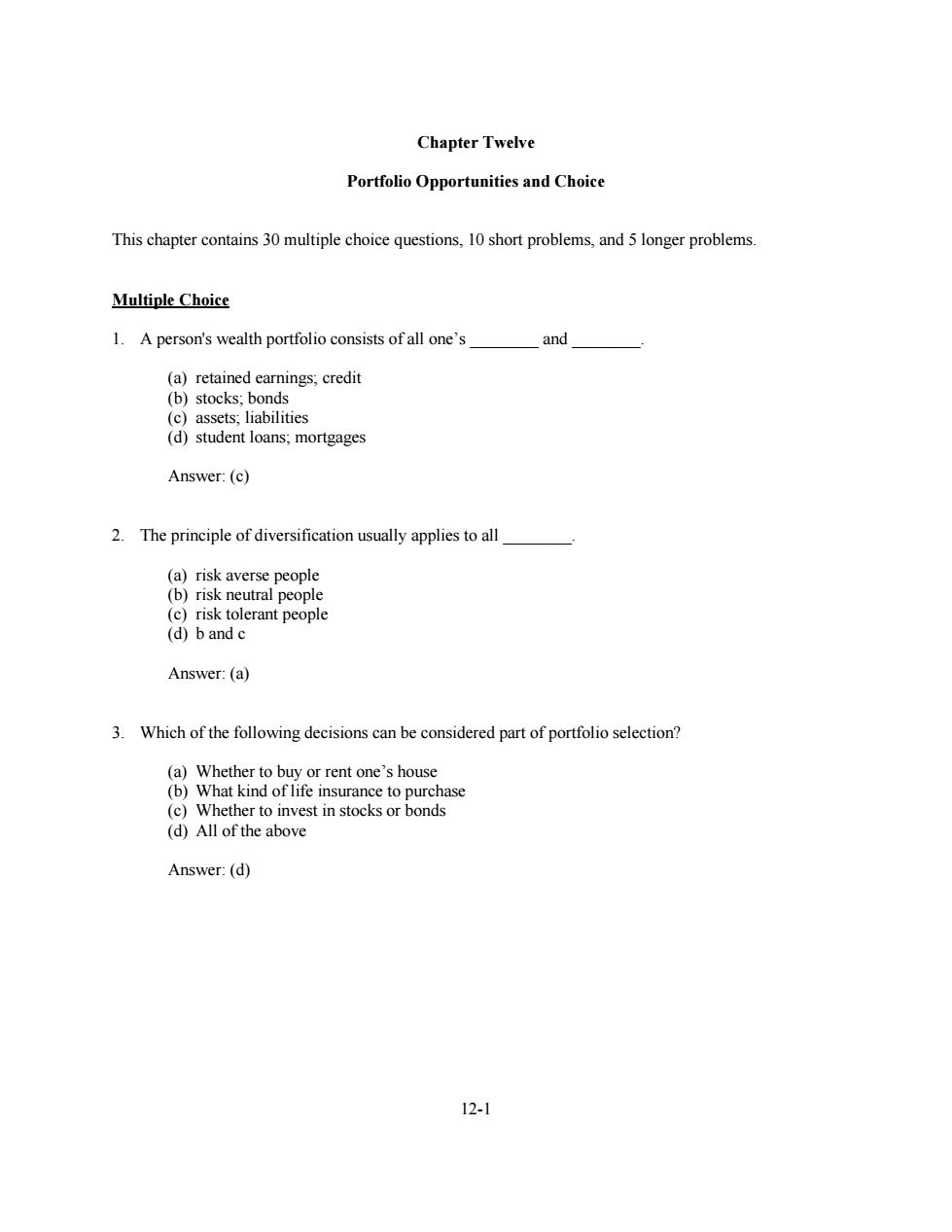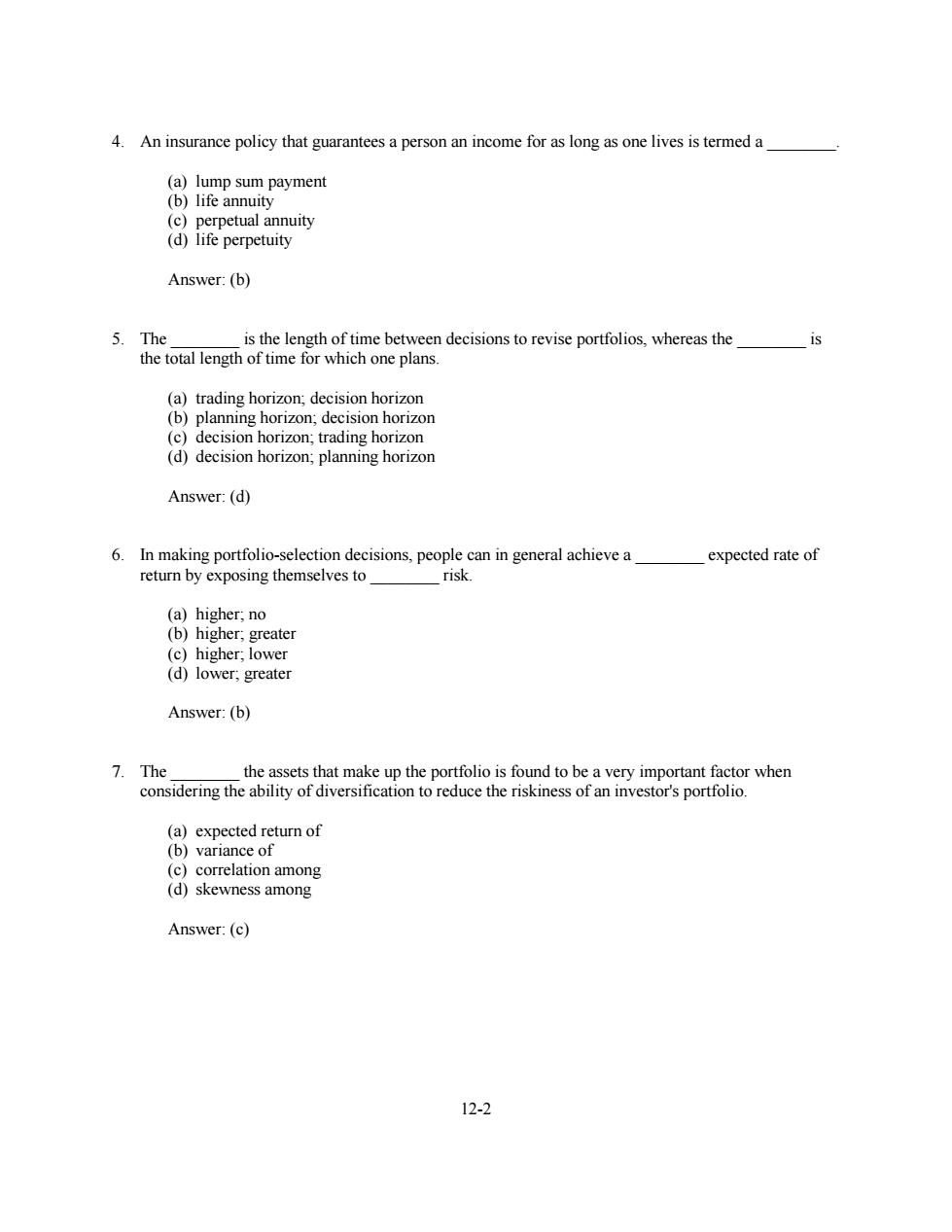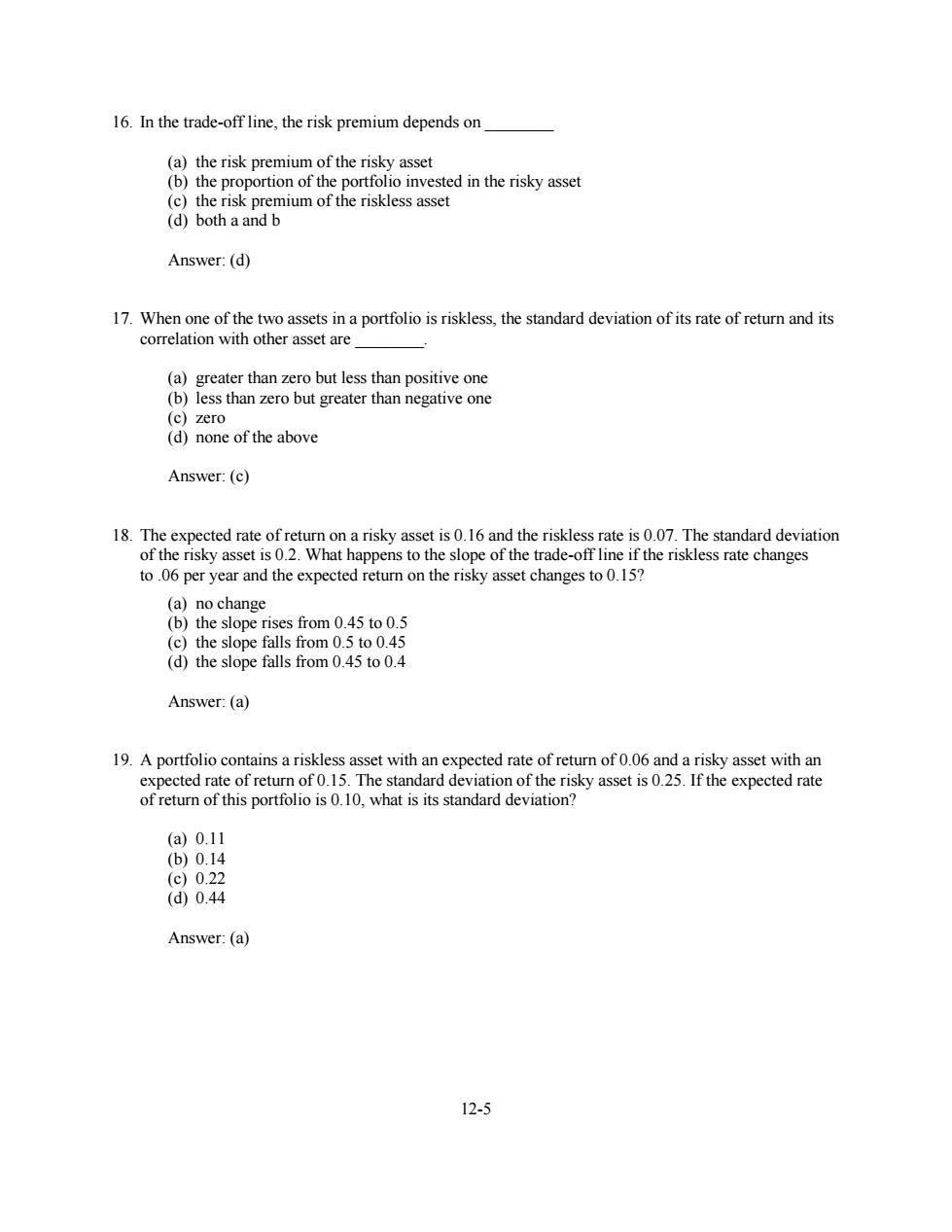
Chapter Twelve Portfolio Opportunities and Choice This chapter contains 30 multiple choice questions,10 short problems,and 5 longer problems. Multiple Choice 1.A person's wealth portfolio consists of all one's and (a)retained earnings;credit (b)stocks;bonds (c)assets;liabilities (d)student loans;mortgages Answer:(c) 2.The principle of diversification usually applies to all (a)risk averse people (b)risk neutral people (c)risk tolerant people (d)b and c Answer:(a) 3.Which of the following decisions can be considered part of portfolio selection? (a)Whether to buy or rent one's house (b)What kind of life insurance to purchase (c)Whether to invest in stocks or bonds (d)All of the above Answer:(d) 12-1
12-1 Chapter Twelve Portfolio Opportunities and Choice This chapter contains 30 multiple choice questions, 10 short problems, and 5 longer problems. Multiple Choice 1. A person's wealth portfolio consists of all one’s ________ and ________. (a) retained earnings; credit (b) stocks; bonds (c) assets; liabilities (d) student loans; mortgages Answer: (c) 2. The principle of diversification usually applies to all ________. (a) risk averse people (b) risk neutral people (c) risk tolerant people (d) b and c Answer: (a) 3. Which of the following decisions can be considered part of portfolio selection? (a) Whether to buy or rent one’s house (b) What kind of life insurance to purchase (c) Whether to invest in stocks or bonds (d) All of the above Answer: (d)

4.An insurance policy that guarantees a person an income for as long as one lives is termed a (a)lump sum payment (b)life annuity (c)perpetual annuity (d)life perpetuity Answer:(b) 5.The is the length of time between decisions to revise portfolios,whereas the the total length of time for which one plans. (a)trading horizon;decision horizon (b)planning horizon;decision horizon (c)decision horizon;trading horizon (d)decision horizon;planning horizon Answer:(d) 6.In making portfolio-selection decisions,people can in general achieve a expected rate of return by exposing themselves to risk. (a)higher;no (b)higher;greater (c)higher;lower (d)lower;greater Answer:(b) 7.The the assets that make up the portfolio is found to be a very important factor when considering the ability of diversification to reduce the riskiness of an investor's portfolio. (a)expected return of (b)variance of (c)correlation among (d)skewness among Answer:(c) 12-2
12-2 4. An insurance policy that guarantees a person an income for as long as one lives is termed a ________. (a) lump sum payment (b) life annuity (c) perpetual annuity (d) life perpetuity Answer: (b) 5. The ________ is the length of time between decisions to revise portfolios, whereas the ________ is the total length of time for which one plans. (a) trading horizon; decision horizon (b) planning horizon; decision horizon (c) decision horizon; trading horizon (d) decision horizon; planning horizon Answer: (d) 6. In making portfolio-selection decisions, people can in general achieve a ________ expected rate of return by exposing themselves to ________ risk. (a) higher; no (b) higher; greater (c) higher; lower (d) lower; greater Answer: (b) 7. The ________ the assets that make up the portfolio is found to be a very important factor when considering the ability of diversification to reduce the riskiness of an investor's portfolio. (a) expected return of (b) variance of (c) correlation among (d) skewness among Answer: (c)

8.Risk tolerance can be influenced by which of the following characteristics? (a)job status (b)age (c)wealth (d)all of the above Answer:(d) 9.The is defined as a security that offers a perfectly predictable rate of return in terms of the unit of account and the length of the investor's decision horizon. (a)riskless asset (b)risky asset (c)30-day bond (d)30-day debenture Answer:(a) 10.A portfolio contains one risky asset and one riskless asset.The expected rate of return on the risky asset is 0.13 and the riskless rate is 0.05.The standard deviation of the risky asset is 0.2,and the standard deviation of the portfolio is 0.075.What is the expected rate of return on the portfolio using the trade-off line? (a0.0490 (b)0.0800 (c)0.0980 (d0.1175 Answer:(b) 11.An investor has a $100,000 investment to allocate between a risky asset and a riskless asset.The equation for the trade-off line is determined to be E(r)=0.05 +0.09w.If the investor is requiring a portfolio composition corresponding to an expected rate of return of 0.11,how much should be invested in the risky asset? (a)$18,181 (b)$33,333 (c)$66,667 (d$81,819 Answer:(c) 12-3
12-3 8. Risk tolerance can be influenced by which of the following characteristics? (a) job status (b) age (c) wealth (d) all of the above Answer: (d) 9. The ________ is defined as a security that offers a perfectly predictable rate of return in terms of the unit of account and the length of the investor's decision horizon. (a) riskless asset (b) risky asset (c) 30-day bond (d) 30-day debenture Answer: (a) 10. A portfolio contains one risky asset and one riskless asset. The expected rate of return on the risky asset is 0.13 and the riskless rate is 0.05. The standard deviation of the risky asset is 0.2, and the standard deviation of the portfolio is 0.075. What is the expected rate of return on the portfolio using the trade-off line? (a) 0.0490 (b) 0.0800 (c) 0.0980 (d) 0.1175 Answer: (b) 11. An investor has a $100,000 investment to allocate between a risky asset and a riskless asset. The equation for the trade-off line is determined to be E(r) = 0.05 + 0.09w. If the investor is requiring a portfolio composition corresponding to an expected rate of return of 0.11, how much should be invested in the risky asset? (a) $18,181 (b) $33,333 (c) $66,667 (d) $81,819 Answer: (c)

12.An investor has a $100,000 investment to allocate between a risky asset and a riskless asset.The equation for the trade-off line is determined to be E(r)=0.07+0.12w.If the investor is requiring a portfolio composition corresponding to an expected rate of return of 0.17,how much should be invested in the riskless asset? (a$16,667 (b)$29,412 (c)$70,588 (d$83,333 Answer:(a) 13.An investor has a $100,000 investment to allocate between a risky asset and a riskless asset.The equation for the trade-off line is determined to be E(r)=0.07+0.12w.If the investor requires a portfolio composition corresponding to an expected rate of return of 0.17,what is the corresponding standard deviation of the portfolio?The standard deviation of risky asset is 0.3. (a)0.05 (b)0.25 (c)0.49 (d0.83 Answer:(b) 14.The expected rate of return on a risky asset is 0.13 and the riskless rate is 0.06.The standard deviation of the risky asset is 0.25.What happens to the slope of the trade-off line if the riskless rate changes to 0.05 per year and the expected return on the risky asset changes to 0.14? (a)No change (b)The slope of the line falls from 36%to 28% (c)The slope of the line rises from 28%to 36% (d)The slope of the line rises from 52%to 56% Answer:(c) 15.The formula for the trade-off line between risk and expected return is (a)E(r)=r+w[E(rs)-ri] (b)E(r)=r+[Er)- (C)E(r)=r+w[E(r)+r月 (d)all of the above Answer:(a) 12-4
12-4 12. An investor has a $100,000 investment to allocate between a risky asset and a riskless asset. The equation for the trade-off line is determined to be E(r) = 0.07 + 0.12w. If the investor is requiring a portfolio composition corresponding to an expected rate of return of 0.17, how much should be invested in the riskless asset? (a) $16,667 (b) $29,412 (c) $70,588 (d) $83,333 Answer: (a) 13. An investor has a $100,000 investment to allocate between a risky asset and a riskless asset. The equation for the trade-off line is determined to be E(r) = 0.07 + 0.12w. If the investor requires a portfolio composition corresponding to an expected rate of return of 0.17, what is the corresponding standard deviation of the portfolio? The standard deviation of risky asset is 0.3. (a) 0.05 (b) 0.25 (c) 0.49 (d) 0.83 Answer: (b) 14. The expected rate of return on a risky asset is 0.13 and the riskless rate is 0.06. The standard deviation of the risky asset is 0.25. What happens to the slope of the trade-off line if the riskless rate changes to 0.05 per year and the expected return on the risky asset changes to 0.14? (a) No change (b) The slope of the line falls from 36% to 28% (c) The slope of the line rises from 28% to 36% (d) The slope of the line rises from 52% to 56% Answer: (c) 15. The formula for the trade-off line between risk and expected return is ________. (a) E(r) = rf + w[E(rs) – rf] (b) E(r) = rf + [E(rs) – rf] (c) E(r) = rf + w[E(rs) + rf] (d) all of the above Answer: (a)

16.In the trade-off line,the risk premium depends on (a)the risk premium of the risky asset (b)the proportion of the portfolio invested in the risky asset (c)the risk premium of the riskless asset (d)both a and b Answer:(d) 17.When one of the two assets in a portfolio is riskless,the standard deviation of its rate of return and its correlation with other asset are (a)greater than zero but less than positive one (b)less than zero but greater than negative one (c)zero (d)none of the above Answer:(c) 18.The expected rate of return on a risky asset is 0.16 and the riskless rate is 0.07.The standard deviation of the risky asset is 0.2.What happens to the slope of the trade-off line if the riskless rate changes to.06 per year and the expected return on the risky asset changes to 0.15? (a)no change (b)the slope rises from 0.45 to 0.5 (c)the slope falls from 0.5 to 0.45 (d)the slope falls from 0.45 to 0.4 Answer:(a) 19.A portfolio contains a riskless asset with an expected rate of return of 0.06 and a risky asset with an expected rate of return of 0.15.The standard deviation of the risky asset is 0.25.If the expected rate of return of this portfolio is 0.10,what is its standard deviation? (a0.11 (b)0.14 (c)0.22 (d0.44 Answer:(a) 12-5
12-5 16. In the trade-off line, the risk premium depends on ________ (a) the risk premium of the risky asset (b) the proportion of the portfolio invested in the risky asset (c) the risk premium of the riskless asset (d) both a and b Answer: (d) 17. When one of the two assets in a portfolio is riskless, the standard deviation of its rate of return and its correlation with other asset are ________. (a) greater than zero but less than positive one (b) less than zero but greater than negative one (c) zero (d) none of the above Answer: (c) 18. The expected rate of return on a risky asset is 0.16 and the riskless rate is 0.07. The standard deviation of the risky asset is 0.2. What happens to the slope of the trade-off line if the riskless rate changes to .06 per year and the expected return on the risky asset changes to 0.15? (a) no change (b) the slope rises from 0.45 to 0.5 (c) the slope falls from 0.5 to 0.45 (d) the slope falls from 0.45 to 0.4 Answer: (a) 19. A portfolio contains a riskless asset with an expected rate of return of 0.06 and a risky asset with an expected rate of return of 0.15. The standard deviation of the risky asset is 0.25. If the expected rate of return of this portfolio is 0.10, what is its standard deviation? (a) 0.11 (b) 0.14 (c) 0.22 (d) 0.44 Answer: (a)